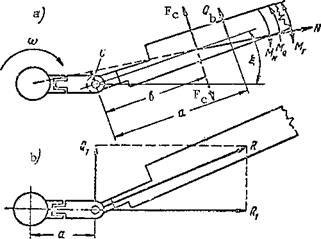Oscillatory Blade Motions
The vertical hinges have stops to limit the oscillatory motions of the blade. However, the blade does not reach the stop in flight, since equilibrium is established under the influence of the moments of the forces acting on the blade in the main rotor hub rotation plane (Figure 47a).
The condition for equilibrium relative to the vertical hinge in general form is expressed by the equality
ХЛ.Н – °-
For a positive lag angle, this equality can be written as
|
Figure 47. Blade equilibrium about vertical hinge. |
MN = MQ±MP.
The lag angle is the angle £ between the radial line and the longitudinal /65 axis of the blade. The radial line is the line passing through the main rotor axis and the vertical hinge axis.
The lag angle will be positive when the blade rotates aft relative to the radial line, opposite the main rotor rotation. In the last equality, the blade centrifugal force moment = Nc will be larger, the larger the centrifugal force and the larger the lag angle. With increase of the lag angle there is an increase of the centrifugal force arm c and its moment relative to the vertical hinge.
For a positive lag angle, the moment rotates the blade ahead in the direction of rotation of the main rotor about the vertical hinge.
If the lag angle is negative, the centrifugal force moment rotates the blade aft, opposite the direction of rotation of the main rotor. Therefore, the centrifugal force moment rotates the blade toward the radial line: it
acts as a sort of regulator of the oscillatory motions. Under the influence of this moment, the positive lag angles £ do not exceed 3-5° (with the main rotor driven by the engine). Negative blade lag angles are developed when the main rotor operates in the autorotation regime. In this case, the lag angles reach 8-12°.
The moment = Qa of the rotational drag force always opposes rotation of the rotor. Since the force varies with azimuth, its moment will also vary.
The Coriolis force moment M^, = F^b varies as a function of azimuth, both in magnitude and direction. At azimuth angles close to 90° the Coriolis force reduces the lag angle, while at azimuths close to 270° the lag is increased.
Now (18) can be written in expanded form
Nc = Q^a + Fcb = 0.
This will then be the condition for equilibrium of the blade relative to the vertical hinge.
The moments and vary continuously in azimuth, and their variation is one of the reasons for the oscillatory motions of the blade relative to the vertical hinge in the forward flight regime.
Another reason for the oscillatory motions is the action of the centrifugal force and its moment relative to the vertical hinge. Its action can be compared with the action of the weight force on a freely suspended body.
If a freely suspended body is deflected, oscillations similar to those of a pendulum develop.
Since the centrifugal force is several times stronger than the weight force, it creates significant "pendulous" oscillations, which combine with the oscillations from the variable moments of the rotational drag force and the Coriolis force to amplify or attenuate the amplitudes of the blade /66
oscillations about the vertical hinge.












